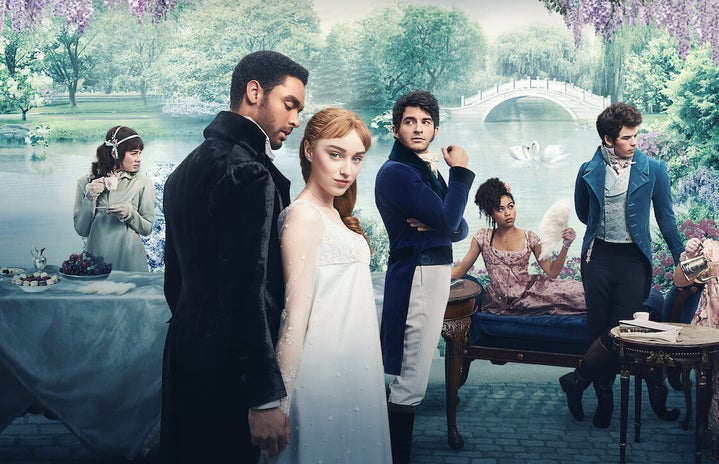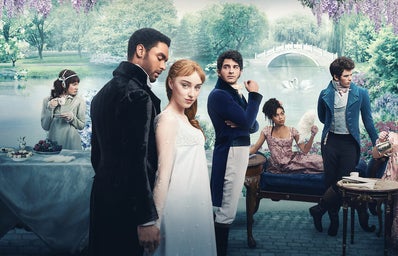Edited by Janani Mahadevan
2020 had some major problems, but let me tell you: it was a great year for regency era entertainment. Autumn de Wilde’s adaptation of Emma and the Netflix adaptation of Julia Quinn’s Bridgerton series both came out last year and they’ve both been big hits. If you’ve read my article on historical romance novels you’ll know that I’m a huge fan of this genre in general. Seeing the beautiful sets, the dresses, the dancing — everything that makes these projects visually stunning — on screen was like watching my imagination come to life. Both Emma and Bridgerton’s aesthetics are seamless, a consistently beautiful world crafted to perfection. However, I do think that we need to pay attention to precisely this—that they are crafted; their aesthetic sensibilities have been developed from specific source material with a certain perspective and a particular aim in mind.
Emma and Bridgerton, although both regency romances, are located differently. Emma is set in the country village of Highbury in England. It is large and populous but still permeated with a more rural atmosphere as compared to the elite and busy London that Bridgerton occupies. The important people of Highbury are those who own landed estates, who are generally educated and considered respectable, whereas in London, the nobility take the top spot (with the Queen at the helm, of course). The social scenes are also differently paced in the two romances. Emma has a slower, more easygoing society; dances are meant to be fun and picnics are all about taking in the fresh air and making use of the opportunity to mingle. Bridgerton, however, is set in an extremely active London ton where everyone knows everyone else (or everyone knows everyone else’s business). It is fast and highly pressurized because each social occasion is filled with the attempts of mothers and daughters to entrap gentlemen into marriage.
Still, there are remarkable similarities between their aesthetic qualities and the way that these two visual masterpieces are presented to us. For one, their dressing style. Of course, both Emma and Bridgerton make use of the style of the regency era with corseted gowns, large headpieces and elaborate hairstyles for the women and high-waisted pants and sideburns for the men (although I could have done without those). But it’s more than their historical accuracy or even their minute inaccuracies. Emma and Bridgerton make use of wide-angled shots of rolling greenery against perfect blue skies, their colour palettes are all soft shades and pops of brightness, and there is a pronounced emphasis on side glances, the locking of gazes and slight grazes of the hand to denote sexual tension. Altogether, they make for very appealing and ideal worlds where it appears that everyone in that era simply dressed up and fell in love.
You can see the appeal of this kind of entertainment just by looking at the fashion trends that have gained popularity after the release of Bridgerton in late December. The sales in Regencycore– which, for lack of a better definition, basically refers to all things in the Regency aesthetic category and is most often used in the context of fashion– have shot up dramatically with everyone looking for corset tops and feathery headbands. Although we have seen such an exponential rise in this trend, vintage and retro styles have always been a part of the fashion world and there has always been a niche section of people who have gravitated towards Regencycore even before the release of things like Emma and Bridgerton (especially around Halloween).
Don’t get me wrong, I’m completely here for that; I love this style of clothing and I could go on for days about the whole aesthetic vibe of Emma and Bridgerton. But, I do think that we need to recognize certain broader things about these kinds of entertainment and our reactions to them. I pointed to this earlier, but both Emma and Bridgerton are made to look idyllic. The softness of their visual aesthetic is meant to leave you in awe, to make you desperately wish that you had lived in that time period. To put a bit of pressure on that idea though, the aesthetic that they present is very white and very privileged. Only the people who could afford to have such elaborate wardrobes made could wear such dresses and attend so many gatherings. The average person certainly was not dressing up in the fashion that we so covet.
Moreover, being a viewer in India, to think about such a society is also to place it in the time of slavery and colonialism. Bridgerton and Emma offer us a romanticized picture of a time that was actually horrific for many other people and the characters we so love on-screen occupy social positions that furthered these atrocities in the name of the empire. But because their cinematic representations focus much more on their present lives, their family and romantic relationships, we don’t necessarily immediately see these larger contexts. Another question that such viewership brings up, at least personally, is why we enjoy seeing such idealizations. The desire to uphold the western, more ‘modern’ (more white) world as being the example we must all strive for is a well-known part of colonial hangover. This is the legacy that the 19th and 20th centuries leave us. No one is thinking of these time periods and saying, “Hey, you know what would be cool? A sari in the style of the 1850s!” The only attractive vintage or retro fashions are those produced in the so-called epitome of civilization, the West.
My point in this article is not to say that you shouldn’t find Emma and Bridgerton visually stunning or that it is somehow wrong to want to own Regencycore anything (I would certainly be a huge hypocrite if that were the case). My point is that there is merit in thinking about why we might enjoy the things that we enjoy or find certain entertainment (or fashion, or even people) desirable. No act of consumption—including, and especially, entertainment—is ‘just for fun’ although they are presented to us that way (this is why we literature majors are considered major buzzkills for analyzing everything we read and watch). When we watch and popularize things like Bridgerton and Emma without recognizing that they are giving us a very minimal picture, we are erasing the histories and the stories of people who lie outside of their purview and letting the visual representation we receive become the entire portrait. This is why I think it was important for this article to reveal, if only slightly, the problems that surround our obsession with Regencycore and to attempt to loosen, if not undo, the seams of the crafted perfection of entertainment like Emma and Bridgerton.



